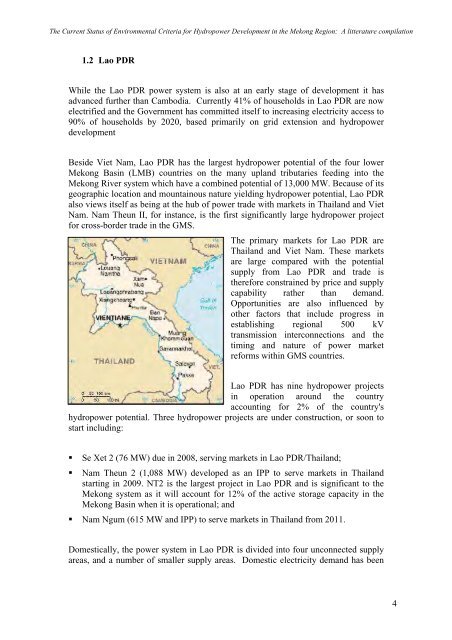Environmental Criteria for Hydropower in the Mekong Region - WWF
Environmental Criteria for Hydropower in the Mekong Region - WWF
Environmental Criteria for Hydropower in the Mekong Region - WWF
You also want an ePaper? Increase the reach of your titles
YUMPU automatically turns print PDFs into web optimized ePapers that Google loves.
The Current Status of <strong>Environmental</strong> <strong>Criteria</strong> <strong>for</strong> <strong>Hydropower</strong> Development <strong>in</strong> <strong>the</strong> <strong>Mekong</strong> <strong>Region</strong>: A litterature compilation<br />
1.2 Lao PDR<br />
While <strong>the</strong> Lao PDR power system is also at an early stage of development it has<br />
advanced fur<strong>the</strong>r than Cambodia. Currently 41% of households <strong>in</strong> Lao PDR are now<br />
electrified and <strong>the</strong> Government has committed itself to <strong>in</strong>creas<strong>in</strong>g electricity access to<br />
90% of households by 2020, based primarily on grid extension and hydropower<br />
development<br />
Beside Viet Nam, Lao PDR has <strong>the</strong> largest hydropower potential of <strong>the</strong> four lower<br />
<strong>Mekong</strong> Bas<strong>in</strong> (LMB) countries on <strong>the</strong> many upland tributaries feed<strong>in</strong>g <strong>in</strong>to <strong>the</strong><br />
<strong>Mekong</strong> River system which have a comb<strong>in</strong>ed potential of 13,000 MW. Because of its<br />
geographic location and mounta<strong>in</strong>ous nature yield<strong>in</strong>g hydropower potential, Lao PDR<br />
also views itself as be<strong>in</strong>g at <strong>the</strong> hub of power trade with markets <strong>in</strong> Thailand and Viet<br />
Nam. Nam Theun II, <strong>for</strong> <strong>in</strong>stance, is <strong>the</strong> first significantly large hydropower project<br />
<strong>for</strong> cross-border trade <strong>in</strong> <strong>the</strong> GMS.<br />
The primary markets <strong>for</strong> Lao PDR are<br />
Thailand and Viet Nam. These markets<br />
are large compared with <strong>the</strong> potential<br />
supply from Lao PDR and trade is<br />
<strong>the</strong>re<strong>for</strong>e constra<strong>in</strong>ed by price and supply<br />
capability ra<strong>the</strong>r than demand.<br />
Opportunities are also <strong>in</strong>fluenced by<br />
o<strong>the</strong>r factors that <strong>in</strong>clude progress <strong>in</strong><br />
establish<strong>in</strong>g regional 500 kV<br />
transmission <strong>in</strong>terconnections and <strong>the</strong><br />
tim<strong>in</strong>g and nature of power market<br />
re<strong>for</strong>ms with<strong>in</strong> GMS countries.<br />
Lao PDR has n<strong>in</strong>e hydropower projects<br />
<strong>in</strong> operation around <strong>the</strong> country<br />
account<strong>in</strong>g <strong>for</strong> 2% of <strong>the</strong> country's<br />
hydropower potential. Three hydropower projects are under construction, or soon to<br />
start <strong>in</strong>clud<strong>in</strong>g:<br />
Se Xet 2 (76 MW) due <strong>in</strong> 2008, serv<strong>in</strong>g markets <strong>in</strong> Lao PDR/Thailand;<br />
Nam Theun 2 (1,088 MW) developed as an IPP to serve markets <strong>in</strong> Thailand<br />
start<strong>in</strong>g <strong>in</strong> 2009. NT2 is <strong>the</strong> largest project <strong>in</strong> Lao PDR and is significant to <strong>the</strong><br />
<strong>Mekong</strong> system as it will account <strong>for</strong> 12% of <strong>the</strong> active storage capacity <strong>in</strong> <strong>the</strong><br />
<strong>Mekong</strong> Bas<strong>in</strong> when it is operational; and<br />
Nam Ngum (615 MW and IPP) to serve markets <strong>in</strong> Thailand from 2011.<br />
Domestically, <strong>the</strong> power system <strong>in</strong> Lao PDR is divided <strong>in</strong>to four unconnected supply<br />
areas, and a number of smaller supply areas. Domestic electricity demand has been<br />
4

















